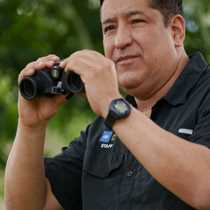After a few hours of late-night navigating, we opened our eyes in the harbor of Puerto Ayora on Santa Cruz Island. Santa Cruz is one of the largest islands in the archipelago, as well as the most populated. We took a very short bus ride to the Charles Darwin Research Station where we learned more about the restoration process of the giant tortoises. Part of this effort involves collecting tortoise eggs and bringing them to the station where they will finish their incubation period. This is done in order to protect them from animals such as wild pigs, goats, and fire ants that would otherwise destroy them. Once hatched and allowed to grow for a few years, these young tortoises will be repatriated to their homes on different islands.
During our visit we observed lots of tortoises, from very young hatchlings to large mature reptiles. We were lucky to see one tortoise in particular, Diego, who after spending many years at the San Diego Zoo in California was repatriated and has become part of this very successful restoration program. In the late seventies, only fourteen tortoises were found on Espanola Island. Scientist realized there were missing member of this population, such as Diego, who was sent to the California Zoo. After some time these tortoises were returned to the Galapagos, and today approximately 3,000 individuals have been bred from 12 females and 3 males who were returned to Espanola Island.
After this interesting visit we had the opportunity to explore the town, and then travel to a local farm in the highlands where we learned about how coffee beans are processed as well as how you derive liquor from sugar cane. The highlands soil is rich so many crops and fruits are grown; things like oranges, lemons, grapes, and corn. Local people make their living through agriculture, fishing, and of course tourism.
For lunch we visited another farm for a delicious buffet. Afterward, we split into smaller groups to explore the area and see giant tortoises living in their natural environment. Some were found relaxing in freshwater pools. This is done to regulate their body temperature and get rid of skin parasites. What an interesting experience! We enjoyed a beautiful sunset on our return to National Geographic Islander. A lovely ending to fun-filled day.







